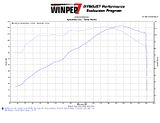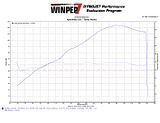JamesK
Got to ride
I hope you guys can point me in the right direction to look for this problem as I'm running out of ideas.
I have a 2007 FJR1300A with ~208k miles on the ODO. The engine is still strong and everything else works (has been maintained as needed).
I've read through the various "Intermittently Stalling" threads but the issues listed don't exactly apply to me.
This problem seems to have started suddenly and only recently, no work has been done on the bike in the recent past/before this problem manifested itself.
The stalling happens at what seems totally intermittent times, not related to cold or hot engine state, throttle blips, etc. The one somewhat constant is that the bike is harder to start after the slow stall, almost feels like it's flooded as WOTL seems to have the best effect at restarting. The problem as I mentioned is that I can't seem to find any particular factor which leads to the stalling, sometimes the bike idles normally and other times it will either stall quite quickly or slowly drop RPM until it stalls (only takes maybe 30 seconds or less). The harder starts are after the slow stalling vs. the immediate stall. I have tried increasing the Idle RPM to 1,500 (current setting) but that does not make any difference other than possibly add a few seconds before the "slow stall" condition.
DIAG Checks:
- There are no Fault Codes displayed - d61:00
- The injectors each work (click 4 times) as described in the FSM diag tests.
- The fuel pump relay clicks 4 times as well and can be heard running if the Run/Stop switch is in the Run position. The one thing that does not match the FSM is he fuel system voltage. The diag shows 11V, while the Datel indicates 12.5V. Also the fuel pump initializes normally when the ignition is first turned on.
- The TPS diag d01: 17-100 range of motion per FSM.
- The rest of the Diag tests all pass according to the FSM.
The battery is always (including now) on a Battery Tender and is a Gel battery only about 1 year old.
As part of this problem, when the bike would stall if throttle is released it feels like it's not running on all cylinders, in the way the engine feels and sounds. However, this again is intermittent, so at other times the engine sounds normal and has full power.
The engine is not burning oil (any more than ever), the inside of the exhaust only has a very light black coating if you run your finger over it, as is expected with my current fueling configuration. Gas mileage is normal (unchanged from before). Using Regular or Premium gas makes no difference to this problem. I have run though many full tanks of gas purchased at different gas stations/companies and have run Seafoam in the tank. I have done multi-hundred mile highway runs siting on 80+ MPH to "flush" the system, etc.
I've already checked and cleaned (with brake cleaner and compressed air) all the Injector, ECU, TPS, PCIII, fuel pump, etc. connectors - no corrosion or grease was found on any of these and all seem to be making good contact.
Below is a list of related mods/farkles:
- Barbarian Mod - with CO bumped up by 5 over stock settings
- PCIIUSB, running the modified Wally Smoothness Map and O2 Sensor reconnected (ala HaulinAsh write up)
- Blueflame EVOIII slipons
- UNI Air Filter - cleaned and re-oiled 6k miles ago
- Airbox Opened up at the RHS side (to match the snorkel whole opening and snorkel cover removed)
- PAIR System removed and blocked off with the Wynpro plates
- New TPS unit - new part number for the 2009 model - about 15k miles ago
- New Air Temp Sensor (the one in the airbox) - about 15k miles ago
- Used very low mileage Coils and Leads
- Fuel Injectors Inspected and cleaned in with gas
- Injector cleaner and Seafoam run through a few tanks of gas
- Idle set at 1,200 rpm
- New NGK Iridium Plugs - 600 miles ago. The old plugs (with around 18k miles on them looked good, and I am sure where fine).
- DIAG tests performed per FSM - for fuel pump, each injector, spark, etc.
- TBS done 15k miles ago - virtually no adjustment was needed
- Throttle cable replaced at 180k and confirmed recently to be working smoothly
- Butterfly valves checked and cleaned at 170k
- All linkages inspected and re-lubed recently
This is was the bike on the Dyno at a little over 200k (done in mid June), engine running strong and putting down good power, at least for the mileage on her.



I have a 2007 FJR1300A with ~208k miles on the ODO. The engine is still strong and everything else works (has been maintained as needed).
I've read through the various "Intermittently Stalling" threads but the issues listed don't exactly apply to me.
This problem seems to have started suddenly and only recently, no work has been done on the bike in the recent past/before this problem manifested itself.
The stalling happens at what seems totally intermittent times, not related to cold or hot engine state, throttle blips, etc. The one somewhat constant is that the bike is harder to start after the slow stall, almost feels like it's flooded as WOTL seems to have the best effect at restarting. The problem as I mentioned is that I can't seem to find any particular factor which leads to the stalling, sometimes the bike idles normally and other times it will either stall quite quickly or slowly drop RPM until it stalls (only takes maybe 30 seconds or less). The harder starts are after the slow stalling vs. the immediate stall. I have tried increasing the Idle RPM to 1,500 (current setting) but that does not make any difference other than possibly add a few seconds before the "slow stall" condition.
DIAG Checks:
- There are no Fault Codes displayed - d61:00
- The injectors each work (click 4 times) as described in the FSM diag tests.
- The fuel pump relay clicks 4 times as well and can be heard running if the Run/Stop switch is in the Run position. The one thing that does not match the FSM is he fuel system voltage. The diag shows 11V, while the Datel indicates 12.5V. Also the fuel pump initializes normally when the ignition is first turned on.
- The TPS diag d01: 17-100 range of motion per FSM.
- The rest of the Diag tests all pass according to the FSM.
The battery is always (including now) on a Battery Tender and is a Gel battery only about 1 year old.
As part of this problem, when the bike would stall if throttle is released it feels like it's not running on all cylinders, in the way the engine feels and sounds. However, this again is intermittent, so at other times the engine sounds normal and has full power.
The engine is not burning oil (any more than ever), the inside of the exhaust only has a very light black coating if you run your finger over it, as is expected with my current fueling configuration. Gas mileage is normal (unchanged from before). Using Regular or Premium gas makes no difference to this problem. I have run though many full tanks of gas purchased at different gas stations/companies and have run Seafoam in the tank. I have done multi-hundred mile highway runs siting on 80+ MPH to "flush" the system, etc.
I've already checked and cleaned (with brake cleaner and compressed air) all the Injector, ECU, TPS, PCIII, fuel pump, etc. connectors - no corrosion or grease was found on any of these and all seem to be making good contact.
Below is a list of related mods/farkles:
- Barbarian Mod - with CO bumped up by 5 over stock settings
- PCIIUSB, running the modified Wally Smoothness Map and O2 Sensor reconnected (ala HaulinAsh write up)
- Blueflame EVOIII slipons
- UNI Air Filter - cleaned and re-oiled 6k miles ago
- Airbox Opened up at the RHS side (to match the snorkel whole opening and snorkel cover removed)
- PAIR System removed and blocked off with the Wynpro plates
- New TPS unit - new part number for the 2009 model - about 15k miles ago
- New Air Temp Sensor (the one in the airbox) - about 15k miles ago
- Used very low mileage Coils and Leads
- Fuel Injectors Inspected and cleaned in with gas
- Injector cleaner and Seafoam run through a few tanks of gas
- Idle set at 1,200 rpm
- New NGK Iridium Plugs - 600 miles ago. The old plugs (with around 18k miles on them looked good, and I am sure where fine).
- DIAG tests performed per FSM - for fuel pump, each injector, spark, etc.
- TBS done 15k miles ago - virtually no adjustment was needed
- Throttle cable replaced at 180k and confirmed recently to be working smoothly
- Butterfly valves checked and cleaned at 170k
- All linkages inspected and re-lubed recently
This is was the bike on the Dyno at a little over 200k (done in mid June), engine running strong and putting down good power, at least for the mileage on her.



Last edited by a moderator:






























































